I’ve learned over time that loudness isn’t about pushing everything to the ceiling – it’s about control. The best limiters today don’t just protect from clipping, they shape the final energy of your mix. When you find one that holds the punch together and keeps the tone honest, you stick with it.
These are the ones that consistently deliver that balance between clean and powerful!
Leapwing LimitOne
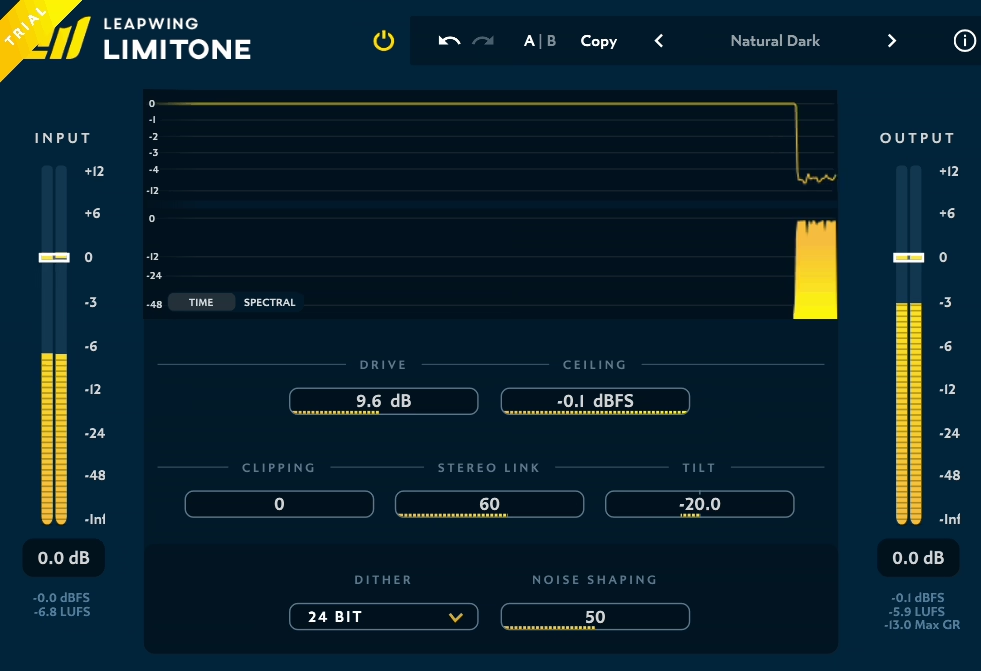
This feels like a no-nonsense limiter. I tried it on a mix with sharp drums and heavy bass, and Leapwing LimitOne kept both in line without squashing the life out of them. Its hybrid design combines spectral and time-based processing, so it reacts to frequencies and transients in a balanced way. The Pufferfish engine handles tone and energy across the spectrum, while Hedgehog shapes peaks and keeps the hits consistent.
The shared Drive and Ceiling controls make setup quick, and the limiter adjusts smoothly without drawing attention to itself. I like that it doesn’t need complicated settings or multiband splits to sound controlled. The Color knob lets you add a touch of character when needed, though it stays pretty subtle. Sometimes too subtle. On certain tracks, especially ones that need more grit or edge, it can feel a bit too restrained. When I just want a track to sound even and finished without artifacts or harshness, LimitOne does that.
Not flashy or hyped, but it holds up even when pushed.
-
Hybrid Processing Architecture Combines spectral and time-based limiting through two engines: Pufferfish handles tonal balance across frequencies, Hedgehog manages transient shaping and peak consistency.
-
Unified Control System Shared Drive and Ceiling parameters control both engines simultaneously.
-
Color Character Control Adds harmonic saturation and tonal variation, adjustable from subtle to moderate.
FabFilter Pro-L 2
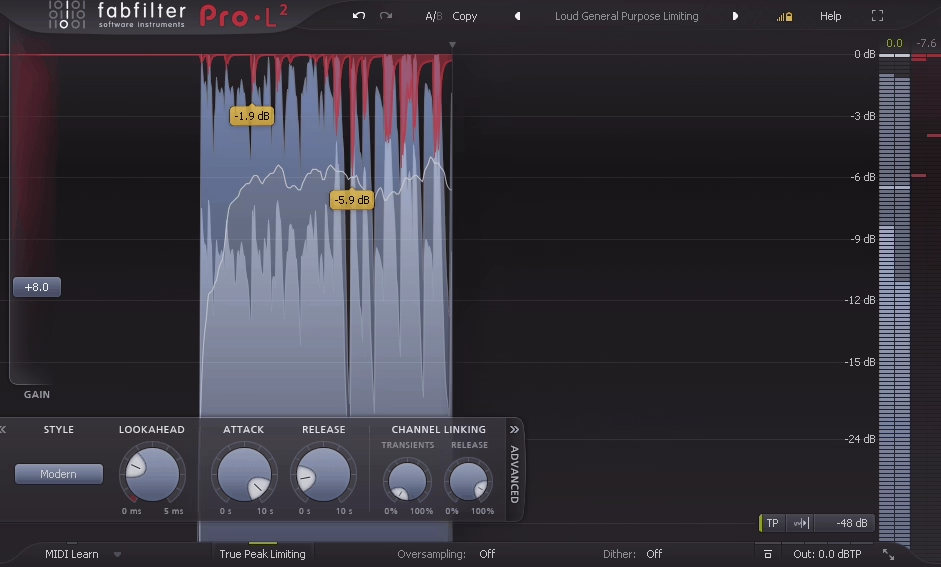
The visual feedback stands out immediately. It’s easy to see exactly what’s happening with FabFilter Pro-L 2, which helps when you’re adjusting by ear and need confirmation that you’re not overdoing it. The interface feels tight, with gain reduction and loudness meters that make sense in real use, not just in theory.
The algorithms cover most situations, from mastering work to tracks that need a little more push. I usually stay in Transparent mode for mixes where I want to preserve punch, but sometimes the Modern or Aggressive modes give me the extra density I’m after. True Peak limiting keeps streaming versions safe, and the Unity Gain option is good for checking what the limiter is actually doing without loudness bias.
Practical and doesn’t get in the way. I’ve spent enough late nights staring at meters to appreciate when they’re actually useful. The one thing that bothers me is how clinical it can feel – you won’t get much color or warmth from it, and that’s fine for most mastering, but some mixes feel too dry when pushed hard. Works best when used with intention, not just slapped on the end of a chain.
- Clear Visual Feedback – Precise metering and gain reduction displays make it easy to see exactly what’s happening, perfect for mastering and fine-tuning by ear.
- Flexible Limiting Modes – Multiple algorithms (Transparent, Modern, Aggressive) handle everything from subtle control to loud, dense mixes, with True Peak and Unity Gain keeping levels honest.
- Clean, Neutral Sound – Prioritizes accuracy over color, delivering transparent results that stay faithful to the mix, though it can feel a bit clinical when pushed.
bx_limiter True Peak
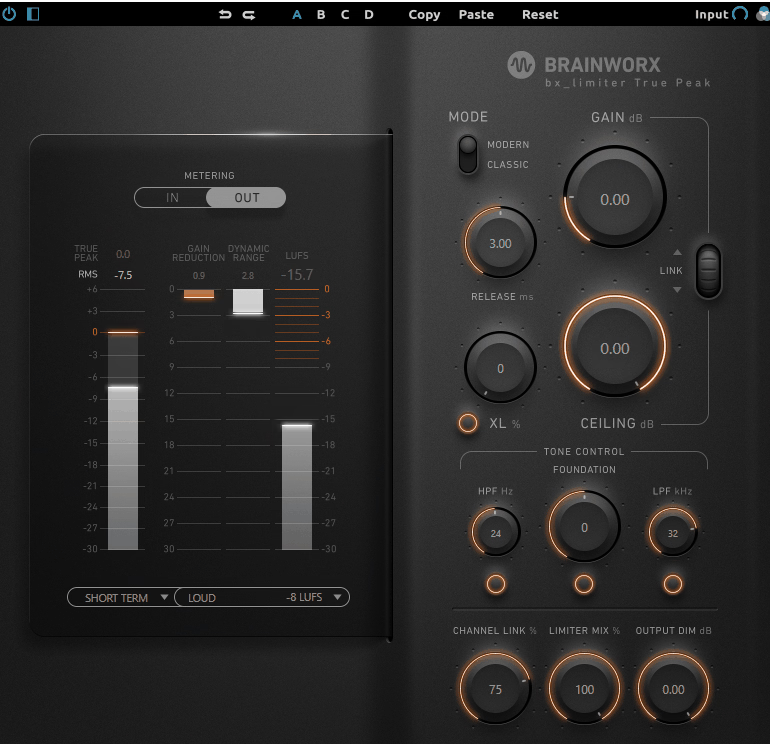
I didn’t expect to like it. Another true peak limiter claiming transparency and punch usually means more of the same. After a few sessions though, bx_limiter True Peak settled in. It feels steady and predictable, like it’s built to solve problems instead of showing off.
The Foundation filter does more than it first appears to – small adjustments shift the weight of a mix without touching an EQ, and that helps when balancing low-heavy tracks late in the chain. XL saturation adds a touch of glue, subtle enough that you forget it’s on until you bypass it. What stands out is how the limiter reacts to bass transients.
The low end stays firm, not smeared or detached like some other limiters do when pushed hard. Switching between Modern and Classic gives two workable tones rather than extremes, so you can match it to the material instead of guessing.
Oversampling only where it matters keeps the phase straight, and the meters tell you everything without clutter. If there’s a downside, the limiter can sound a little reserved – doesn’t give that extra excitement some mixes benefit from. It holds things together and stays out of the way, leaving the mix breathing.
-
Foundation Filter Pre-limiter EQ adjusts tonal weight without frequency-specific controls. Shifts low-end density.
-
XL Saturation Analog-style harmonic glue that integrates before limiting stage.
-
Dual Algorithm Modes Modern and Classic. Modern optimized for transparent peak control, Classic adds subtle analog warmth.
-
True Peak Detection Compliant with ITU-R BS.1770 standard, prevents intersample peaks during D/A conversion.
-
Intelligent Oversampling Applied selectively to maintain phase coherence.
SSL X-Limit
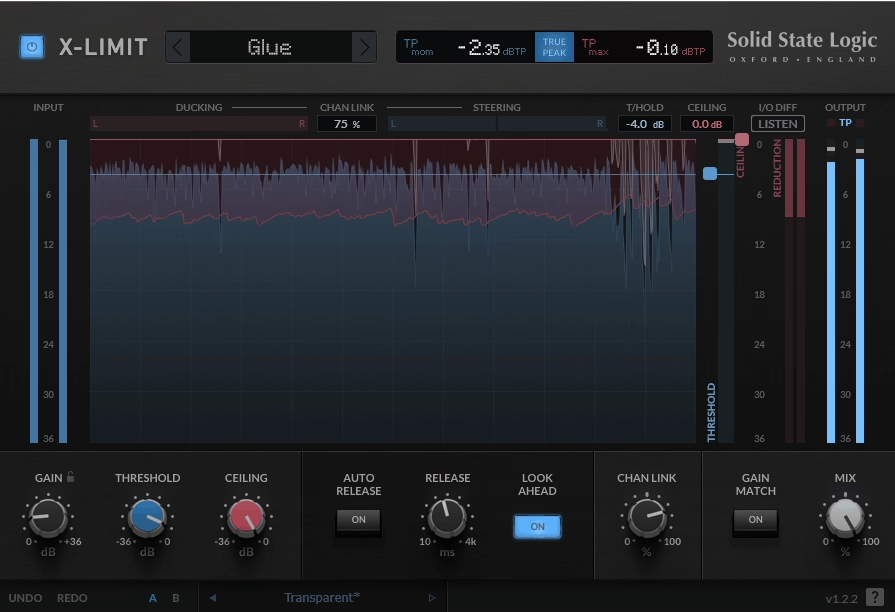
I’ve been using this on masters where I need volume without that crushed top end you get from most limiters that just grab everything and squeeze. The transparent mode is actually transparent, which sounds obvious but most plugins claiming that still smear the highs or add some weird glue you didn’t ask for. SSL X-Limit gives you four flavors and the jump between them is real – punch mode has this forward quality that works on dense mixes, glue does what it says without turning everything to mush.
The lookahead is fast enough that you can track through it without that swimmy feeling some lookahead designs give you. I keep coming back to the auto release because it adapts without me thinking about it, and the ducking meter actually shows you what’s getting hit hardest so you’re not just guessing.
Had a rap mix last week where that meter saved me from chasing ghosts in the low mids. The waveform display helps but I wish it showed more gain reduction history because sometimes I want to see what happened two bars ago. Mix knob makes parallel limiting easy when you need some dynamic life back.
- Transparent Limiting That Holds Up – The Transparent mode truly keeps the top end intact without the smeared highs or unwanted glue most “clean” limiters add. It keeps things open and detailed even at higher gain levels
- Four Distinct Limiting Styles – SSL X-Limit offers four modes – Transparent, Punch, Glue, and one extra for more edge – and they actually sound different. Punch brings forward energy for dense mixes, while Glue tightens without collapsing dynamics
- Responsive Lookahead and Smart Auto Release – The fast lookahead makes it smooth enough for tracking without latency haze, and the auto release adapts naturally, handling different sections without constant tweaking
- Useful Visual and Parallel Tools – The ducking meter shows exactly where the limiter is hitting hardest, helping diagnose problem frequencies, while the mix knob makes parallel limiting simple when you want to bring back a bit of movement or dynamic range
sonible smart:limit
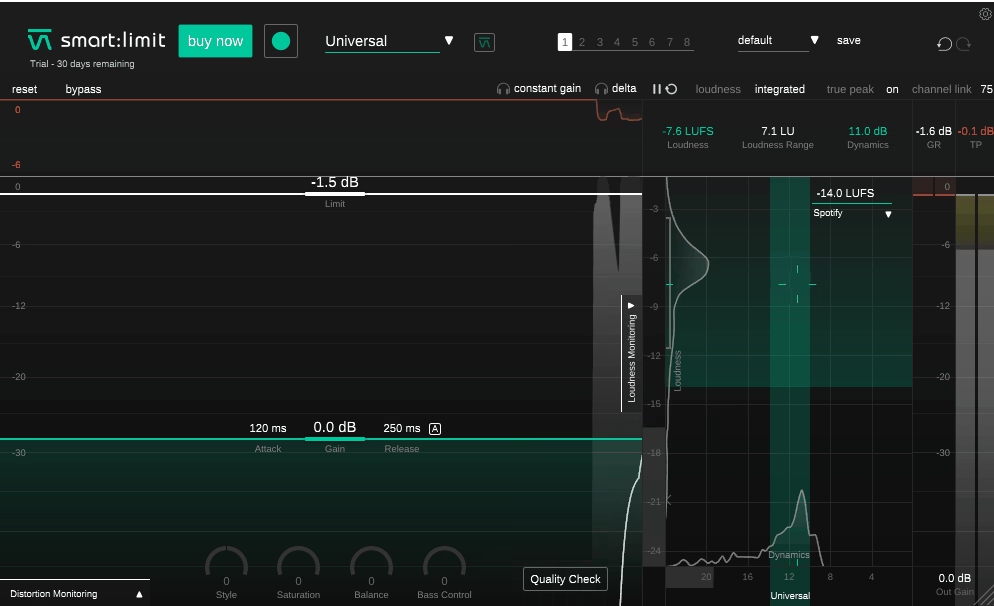
The AI thing actually works here, which surprised me because usually these learning algorithms just make average choices based on average music. Load your track into sonible smart:limit and it sets itself up in seconds, gets you close to where you need to be without that over-squashed sound most auto-limiters chase. The genre profiles help if you’re working in specific lanes but I’ve found just letting it analyze does fine most of the time.
The impact prediction feature lets you twist a knob and immediately see how it changes your loudness numbers without playing anything back, saves you from that constant start-stop-check cycle when you’re trying to hit streaming targets.
The style dial between soft and hard limiting is smooth, no sudden jumps. Balance control is something I use more than I thought I would, just small spectral tweaks that polish things without needing another EQ. The interface feels busy when you’re in hybrid mode with both auto and manual controls visible though – takes a minute to remember what you’re adjusting versus what it’s handling.
-
Adaptive AI Analysis Learns track dynamics in 3-8 seconds, auto-configures all parameters based on spectral and temporal characteristics.
-
Genre Profile System Presets for Electronic, Hip-Hop, Rock, Pop, Classical, Jazz, Ambient, Metal—each adjusts limiting response curves differently.
PluginBoutique PeakLimit
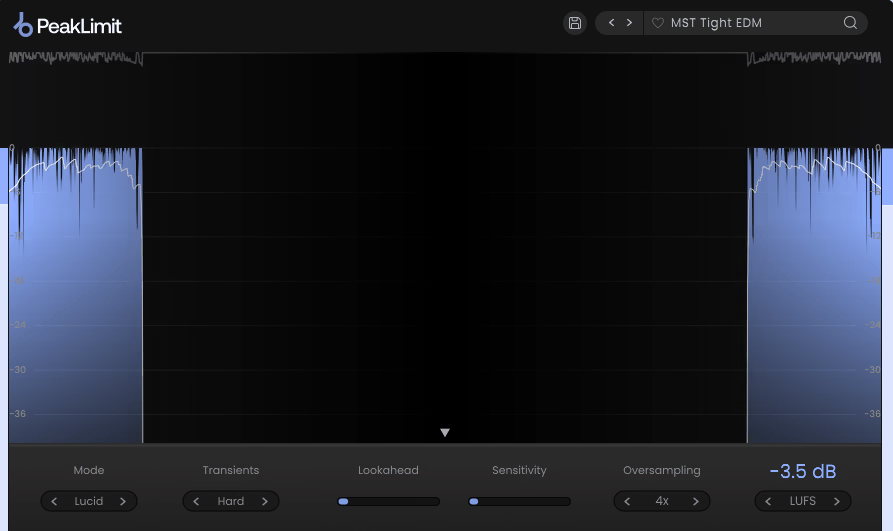
Four modes that shape tone while limiting. Lucid stays neutral. Warm pushes lows without mud. Punch brings dynamics forward on individual tracks. Bright lifts the top end without harshness. You get three transient modes with PluginBoutique PeakLimit – hard, soft, transparent – that determine how it grabs peaks, and the lookahead plus sensitivity controls let you fine-tune the response based on what you’re feeding it.
The metering shows gain reduction, RMS for each channel, output waveform, plus LUFS and peak readouts so you’re not guessing about streaming targets or clipping. Up to 8x oversampling keeps aliasing down when you’re limiting hard, which matters on bright material or higher sample rates.
Adaptive release adjusts automatically based on the incoming audio instead of you babysitting it through dynamic sections. Tested this on a folk track with gentle fingerpicking and it handled the quiet-to-loud shifts without pumping. The four modes can sound too similar on dense mixes where everything is already compressed though – the tonal differences become subtle and you end up wondering if you’re hearing the mode change or just placebo..
- Four tonal modes for character control give PluginBoutique PeakLimit its versatility. Lucid stays clean, Warm adds gentle low-end weight, Punch brings out transients with more bite, and Bright opens the highs without turning brittle. Each one subtly shifts the tone while keeping the limiter musical and controlled.
- Three transient modes for peak handling let you decide how the limiter reacts to sudden hits. Hard, Soft, and Transparent options each have their own feel, and with lookahead plus sensitivity controls, you can fine-tune exactly how tightly it clamps down or lets things breathe.
- Comprehensive metering and oversampling make it easy to see what’s really going on. You get gain reduction and RMS per channel, LUFS and peak readouts, plus an output waveform for visual context. The 8x oversampling helps keep aliasing at bay when you’re pushing levels, especially on bright mixes.
- Adaptive release that feels natural smooths transitions without you needing to constantly tweak it. It reacts to the incoming audio, keeping quieter passages open and louder sections stable. It handled a folk track’s dynamics beautifully in testing, though on already compressed mixes, the tonal modes can start to blur together.
Signum BUTE 2 Limiter
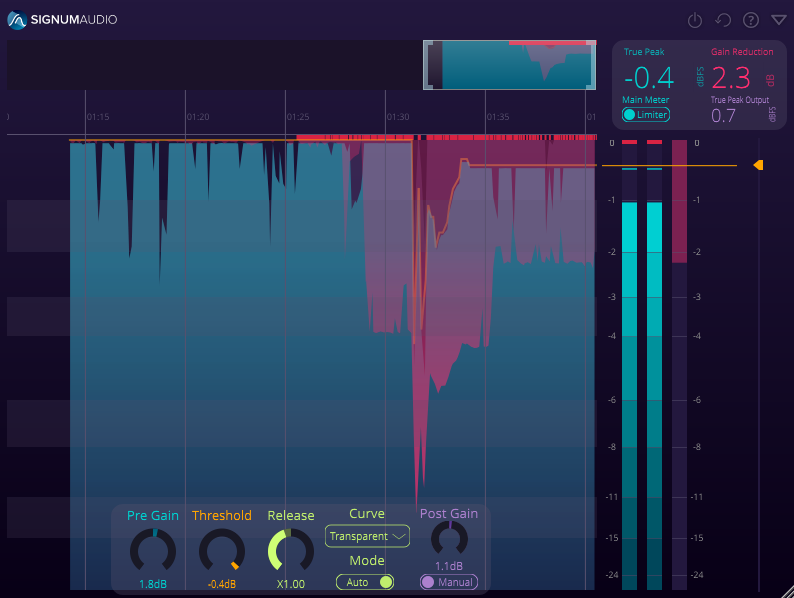
Transparent means it doesn’t mess with your tone while catching peaks. That’s what Signum BUTE 2 Limiter does without the usual side effects you get from aggressive limiting. Pre gain before the brick wall, post gain after. Simple staging but it gives you control over how you approach the ceiling – slam it then pull back, or feed it gently and boost at the end.
Display modes switch between showing just what the limiter did or the combined result with post gain, which helps when you’re debugging why something clips. History view zooms in on any section of the track so you can see gain reduction, threshold, true peak readings over time instead of just guessing from bouncing meters.
It warns you automatically if the post gain creates new peaks past your limit, which saves you from that embarrassing moment when your master clips on certain systems.
The re-metering syncs with your DAW and updates the history when you tweak settings, shows the impact across the whole timeline. The interface packs a lot of info into one screen though and it can feel cramped on smaller displays. You get used to it but the learning curve is steeper than simpler limiters.
-
Dual Gain Staging Pre-gain before limiting stage (±24 dB), post-gain after brick wall (±24 dB). Adjust approach angle to ceiling or compensate output independently
-
Display Mode Switching Limiter-only view or combined pre/post result. Isolates limiter action from gain changes
-
Timeline History View Zoom into any section of the track, review gain reduction curves, threshold position, and true peak readings across entire session. Scrollable and searchable
-
Automatic Peak Warning System Detects when post-gain creates new peaks beyond limit threshold. Visual alert prevents clipping on playback systems
-
DAW-Synced Re-Metering Updates entire history when parameters change. Shows impact across full timeline instantly without re-rendering
Freebies
Press Play Wave Breaker
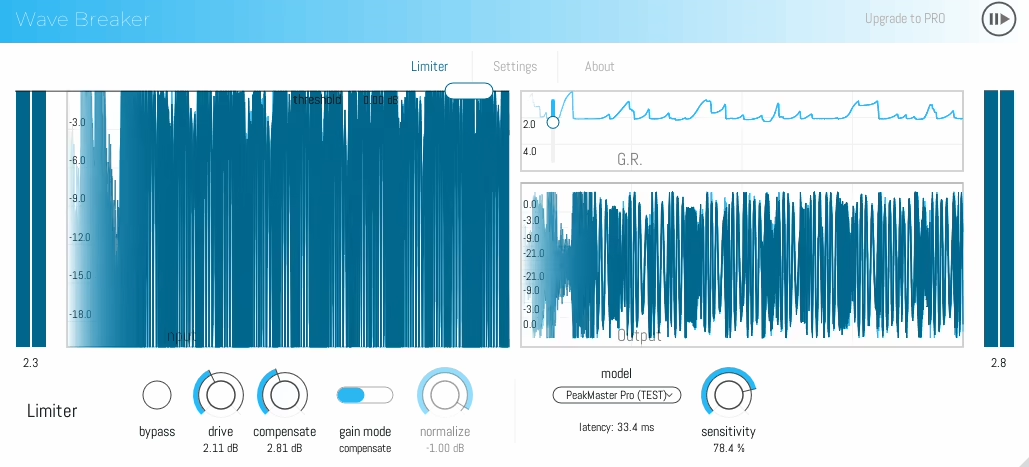
I was mixing a dense track last month and needed something that could handle different limiting approaches without swapping plugins. Three algorithms that sound distinct: Clarity One stays tight and fast for everyday work, PeakMaster Pro adds precision when you’re finalizing masters and latency doesn’t matter, Clipper X goes aggressive when you want that pushed sound.
True peak detection with 4x oversampling at standard rates keeps the high end from getting ugly when you’re limiting hard with Press Play Wave Breaker, which matters more on bright material. Ran it on a guitar-heavy indie track and the top end stayed intact even when I was pushing for streaming loudness.
The algorithm switching is smooth enough that you can compare without worrying about level jumps throwing off your ears.
- Three unique algorithms – Clarity One for fast, tight control, PeakMaster Pro for precision mastering, and Clipper X for aggressive, driven tones.
- True peak detection with 4x oversampling – keeps the highs clean even under heavy limiting, ideal for bright material.
- Smooth algorithm switching – lets you compare modes instantly without distracting level jumps. It handled a guitar-heavy indie mix beautifully, keeping brightness intact while still hitting streaming loudness comfortably.
Analog Obsession LALA

Compressor until you flip the switch. Then it’s a limiter. Both modes make sense in Analog Obsession LALA and the transition is smooth. The frequency controls are what set it apart – MF and MG adjust mid sensitivity, HF does highs. Enhanced R37 setup means it’s surgical about what triggers compression instead of reacting to everything equally.
External sidechain works with the HPF so you can filter out lows before they hit the detector. The 4x oversampling hides behind the logo – click the Analog Obsession label to engage it. Spent ten minutes looking for that the first time I needed it. The LIMIT switch doesn’t change the interface much visually though, so you can forget what mode you’re in. Would be better with a clearer indicator.
- Dual compression/limiting modes – easily switch between compressor and limiter with one control.
- Frequency-focused response – MF, MG, and HF knobs shape how the detector reacts across the spectrum.
- Hidden 4x oversampling – improves top-end smoothness (click the Analog Obsession label to enable).
- External sidechain with HPF – keeps lows from triggering unwanted compression. It’s flexible and punchy, though a clearer mode indicator would make it easier to track what state you’re in during sessions.
D16 Frontier

Auto gain makeup saves time because it compensates while you work instead of making you match levels manually every time you touch the threshold. D16 Frontier handles this without thinking, which matters when you’re moving fast. The control input has a soft clip option that pushes beyond typical limiting – you can drive it into saturation if the track needs it or keep it transparent for peak control..
Works on individual tracks, buses, or the master depending on how hard you set it. The interface doesn’t show what the soft clip is actually doing though – you hear it but there’s no meter or display for the saturation amount, so you’re guessing with your ears when they’re tired at the end of a session.
- Automatic gain makeup – keeps output consistent as you adjust thresholds.
- Soft clip stage – adds analog-style grit when pushed or stays transparent when needed.
- Works on tracks, buses, and masters – adapts easily to different mix stages.
- No visual saturation display – forces you to rely on your ears, which can be tricky when fatigued. Despite that, it’s a go-to limiter when you want solid control without slowing down your workflow.
vladg Limiter №6
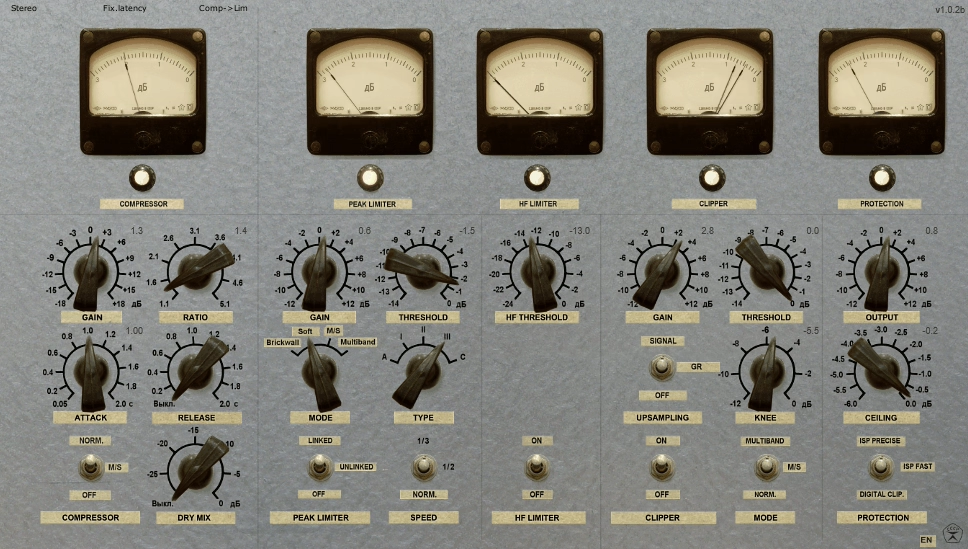
Five modules stacked in series and you can use all of them with small amounts instead of hammering one stage, which keeps things from falling apart when you need serious loudness. An RMS compressor, peak limiter, high-frequency limiter, clipper, and true peak limiter working together in vladg Limiter №6 so each one does a little bit of work instead of one doing everything.
The M/S and multiband modes on the peak limiter and clipper let you control specific frequencies or adjust the stereo field without affecting the whole signal, useful when the sides are too hot or the low mids need more control than the highs.
Optional 4x oversampling on the peak limiter, HF limiter and clipper keeps aliasing down when you’re pushing hard. True intersample peak limiting catches the overshoots that happen during D/A conversion, which most limiters ignore. First time I used this I spent half an hour just figuring out which knob was doing what. The interface gets crowded with five modules visible at once, and it takes time to learn which stage is causing what you’re hearing.
- Five dynamic modules – RMS compressor, peak limiter, HF limiter, clipper, and true peak limiter work together for balanced loudness.
- M/S and multiband options – target stereo width or specific frequencies with precision.
- 4x oversampling and intersample peak limiting – reduce aliasing and prevent digital overs.
Kilohearts Limiter
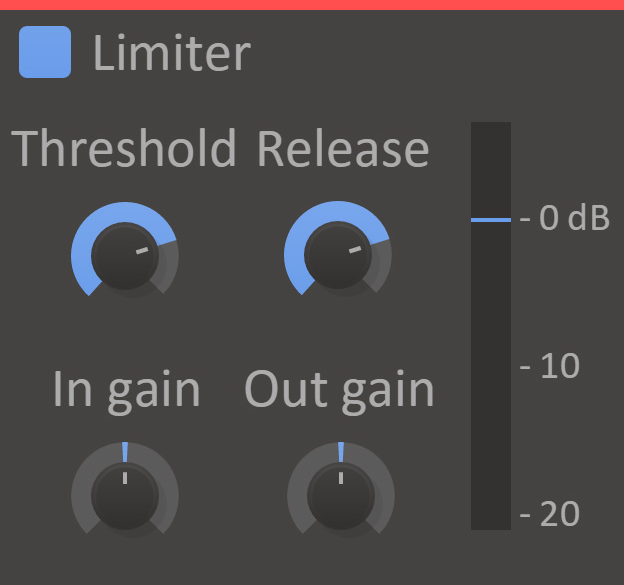
I needed something simple that just worked without menus or modes. Threshold, in gain, out gain, and release. That’s it with Kilohearts Limiter. The VU meter shows input level, your threshold line, and how much attenuation is happening in real time so you’re not guessing.
Independent gain staging means you can push into the limiter hard then back off the output or keep things gentle and boost after. Release control adjusts how fast it recovers after catching peaks. No lookahead option though, which limits how transparent it can be on fast transients. Works well for throwing on a drum bus when you just need quick control without overthinking it.
- Simple interface – threshold, input gain, output gain, and release keep things straightforward
- Real-time VU metering – shows input, threshold, and gain reduction clearly
Sonic Anomaly Unlimited
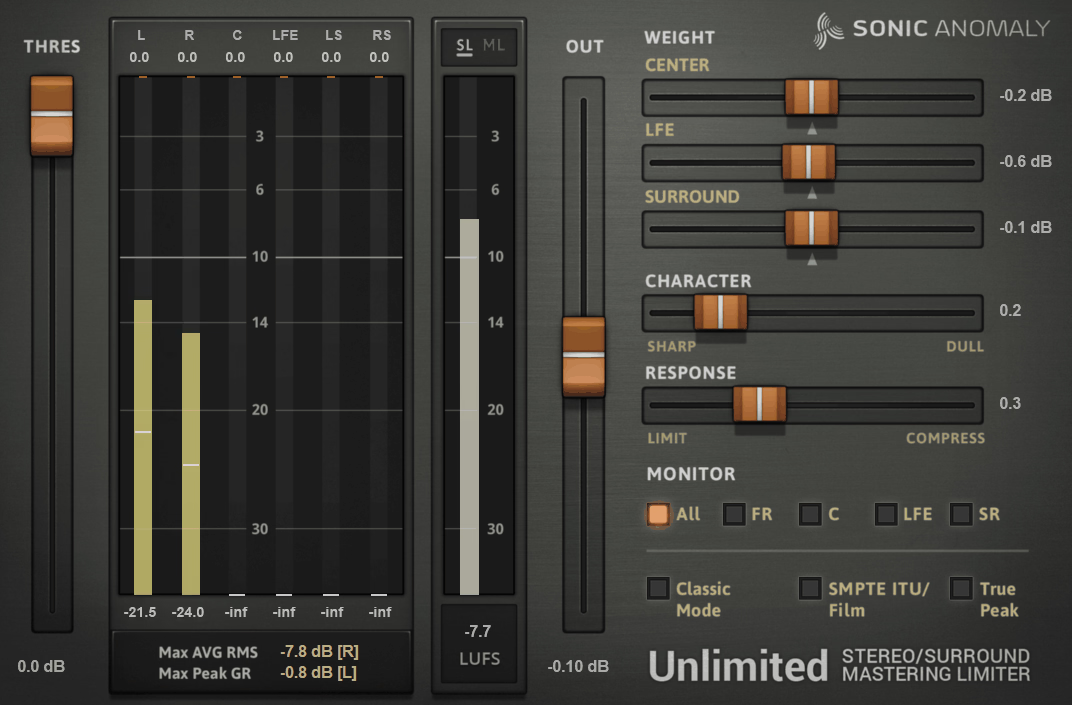
The metering is what pulled me in – LUFS right there alongside RMS so you’re not opening another plugin just to check broadcast standards. Stereo and 5.1 surround with automatic channel detection that saves CPU in Sonic Anomaly Unlimited. Character slider adjusts algorithm aggressiveness – lower values keep transients forward, higher values reduce distortion.
Response slider adds compressor-style gain reduction on top of hard limiting. Classic mode switches between maximizer and traditional limiter behavior. Used this on a podcast edit where I needed consistent LUFS without killing the speaker’s dynamics. The interface doesn’t explain what the weight controls actually do though – you have to experiment to understand how offsetting thresholds affects sound.
- Character and Response sliders – shape tone between punchy and smooth; adds compression-like control
- Comprehensive metering – LUFS and RMS displayed side-by-side for accurate loudness monitoring.
- Classic mode and weight controls – switch between limiter types and adjust threshold behavior across frequencies
Once you get familiar with how the controls interact, Unlimited becomes a precise and powerful loudness tool for both music and broadcast work.
Final Thoughts
Each limiter here has its own thing going on. Some feel invisible, some add a bit of flavor, and some just get you to the finish line fast. LimitOne and smart:limit feel modern and musical, Pro-L 2 and BUTE Limiter 2 bring accuracy and control, and bx_limiter or SSL X-Limit are those stable, dependable tools that never let you down. I hope you found this post helpful and see you next time!

We are plugin nerds (just like you!). We made this website to keep you updated on the latest trends, news and everything plugin related.
